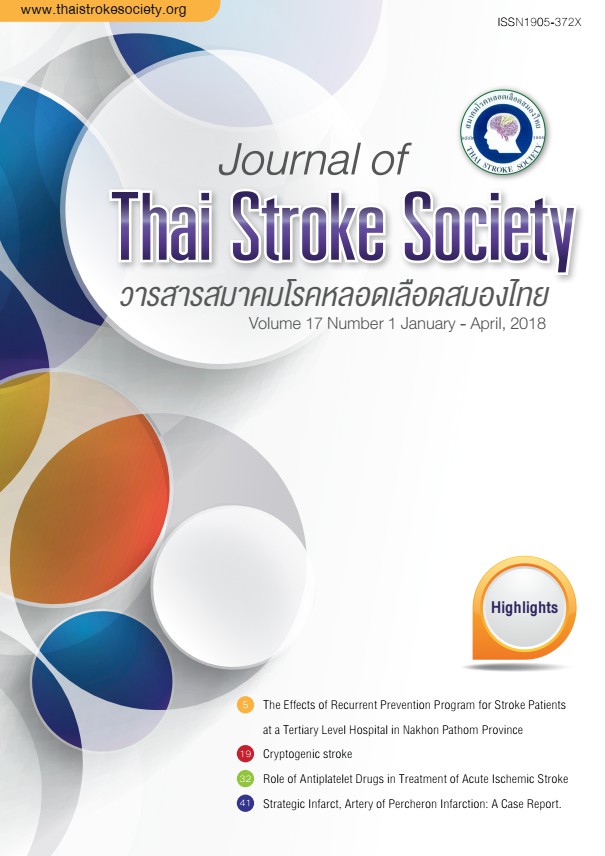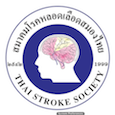Cryptogenic stroke
Keywords:
Cryptogenic stroke, ESUS (Embolic Stroke of Undetermined Source), occult atrial fibrillation, patent foramen ovaleAbstract
Cryptogenic stroke can be found one quarter of all ischemic stroke patient. Most of cryptogenic stroke is caused by emboli in origin and defined as ESUS.Standard work up to define the cause of cryptogenic stroke should be including echocardiography, 24-hour cardiac monitoring, intracranial and extracranial vascular imaging and blood tests for hypercoagulable state.Most possible potential causes of cryptogenic stroke are occult AF, PFO and non-stenosis ulcerated atherosclerotic plaque.Currently, guideline treatment of cryptogenic stroke, including combination of antiplatelet medication and modified stroke risk factors. Long term cardiac monitoring can detect more atrial fibrillation (AF) which should be beneficial for anticoagulant therapy.However, further ongoing large RCT should give more data and will suggest how to manage in these patient groups.
References
bank. Stroke.2001; 32(11):2559–66.
Putaala J, Metso AJ, Metso TM, et al. Analysis of 1008 consecutive patients aged 15 to 49 with first-ever ischemic stroke the Helsinki young stroke registry. Stroke. 2009; 40(4):1195–203.
Li L, Yiin GS, Geraghty OC, et al. Incidence, outcome, risk factors, and long-term prognosis of cryptogenic transient ischaemic attack and ischaemic stroke: a population-based study. Lancet Neurol.2015; 14:903-913.
Ji R, Schwamm LH, Pervez MA, et al. Ischemic stroke and transient ischemic attack in young adults: risk factors, diagnostic yield, neuroimaging, and thrombolysis. JAMA Neurol. 2013; 70(1):51-7.
Wolf ME, Grittner U, Böttcher T, et al. Phenotypic ASCO Characterisation of Young Patients with Ischemic Stroke in the Prospective Multicentre Observational sifap1 study. Cerebrovasc Dis. 2015; 40(3-4):129-35.
Saver JL. Clinical practice: Cryptogenic stroke. N Engl J Med. 2016; 374(21):2065-74
Sacco RL, Ellenberg JH, Mohr JP, et al. Infarcts of undetermined cause: the NINCDS Stroke Data Bank. Ann Neurol.1989; 25(4):382-90.
Kunitz SC, Gross CR, Heyman A, et al. The pilot Stroke Data Bank: definition, design, and data. Stroke. 1984; 15(4):740-6.
Foulkers MA, Wolf PA, Price TR, et al, The Stroke Data Bank: design, methods, and baseline characteristics. Stroke. 1988;
19(5):547-54.
Adams HP, Jr., Bendixen BH, Kappelle LJ, et al. Classification of subtype of acute ischemic stroke. Definitions for use in a multicenter clinical trial. TOAST. Trial of Org 10172 in Acute Stroke Treatment. Stroke. 1993; 24(1):35-41.
Meschia JF, Barrett KM, Chukwudelunzu F, et al. Interobsever agreement in the trial of org 10172 in acute stroke treatment classification of stroke based on retrospective medical record review. J Stroke Cerebrovasc Dis. 2006; 15(6):266-72.
Arsava EM, Ballabio E, Benner T, et al. The Causative Classification of Stroke system: an international reliability and optimization study. Neurology. 2010; 75(14):1277-84.
Rolfs A, Fazekas F, GrittnerU,et al. Acute cerebrovascular disease in the young: the Stroke in Young Fabry Patient study. Stroke. 2013; 44(2):340-9
Jauch EC, Sever JL, Adams HP, Jr., et al. Guidelines for the early management of patients with acute ischemic stroke: a guideline for healthcare professionals from the American Heart Association/American Stroke Association. Stroke. 2013; 44(3):870-947.
Freilinger TM, Schindler A, Schmidt C, et al. Prevalence of nonstenosing, complicated atherosclerotic plaques in cryptogenic stroke. JACC Cardiovasc Imaging. 2012; 5(4): 397-405.
Coutinho JM, Derkatch R, Potvin AR, et al. Nonstenotic carotid plaque on CT angiography in patients with cryptogenic stroke. Neurology. 2016; 87(7):665-72.
Yaghi S, Elkind MS. Cryptogenic stroke: A diagnostic challenge. Neurol Clin Pract.2014; 4(5):386-393
Knebel F, Masuhr F, von Hausen W, et al. Transesophageal echocardiography in patients with cryptogenic cerebral ischemia.
Cardiovasc Ultrasound. 2009;7:15.
Rus Mansilla C, Mesa Rubio D, Suárez de Lezo Cruz Conde J, et al. Utility of transesophageal echocardiography in young
patients with cryptogenic stroke and low cardiovascular risk. Med Clin (Barc). 2008; 130(7): 241-5.
Ferry JM, Massaro AR and Mas JL. Aetiology diagnosis of ischemic stroke in young adults. Lancet Neurol. 2010; 9(11):1085-96.
Bang OY, Ovbiagele B and Kim JS. Evaluation of cryptogenic stroke with advanced diagnostic techniques. Stroke.2014; 45(4):1186-94.
Hart RG, Diener HC, Coutts SB, et al. Embolic strokes of undetermined source: the case for a new clinical construct. Lancet
Neurol. 2014; 13(4):429–38.
Perera KS, VanasscheT, Bosch J, et al. Embolic strokes of undetermined source : prevalence and patient features in the
ESUS Global Registry. Int J Stroke. 2016; 11(5):526-33.
Ntaios G, Lip G, Vemmos K, et al. Ageand sex-specific analysis of patients with embolic stroke of undetermined source. Neurology. 2017; 89(6):532-539.
Hart RG, Catanese L, Perera K, et al. Embolic Strokes of Undetermined Source: A Systematic Review and Clinical Update.Stroke.2017; 48(40):867-872.
Keandoungchun J. Embolic Strokes of Undetermined Source. J Thai Stroke Soc.2017; 16(1):16-22.
Ntaios G, Papavasileiou V, Milionis H, et al. Embolic strokes of undetermined source in the Athens stroke registry: a descriptive
analysis. Stroke. 2015; 46(1):176–81.
Putaala J, Nieminen T, Haapaniemi E, et al. Undetermined stroke with an embolic pattern–a common phenotype with high early recurrence risk. Ann Med. 2015; 47(5):406– 13.
Perera KS, Vanassche T, Bosch J, et al. Embolic strokes of unde-termined source: Prevalence and patient features in the ESUS
Global Registry. Int J Stroke. 2016; 11(5):526–33.
Katsanos AH, Bhole R, Frogoudaki A, et al. The value of transesophageal echocardiography for embolic strokes of undetermined source. Neurology. 2016; 87(10):988–95.
Ueno Y, Yamashiro K, Tanaka R, et al. Emerging Risk Factors for Recurrent Vascular Events in Patients With Embolic Stroke of Undetermined Source. Stroke. 2016; 47(11):2714–2721.
Gratz PP, Gralla J, Mattle HP, et al. Embolic strokes of undetermined source: support for a new clinical construct. Lancet Neurol. 2014; 13(10):967.
Boeckh-Behrens T, Kleine JF, Zimmer C, et al. Thrombus Histology Suggests Cardioembolic Cause in Cryptogenic Stroke. Stroke. 2016; 47(7):1864–71.
Paciaroni M, Agnelli G, Caso V, et al. Atrial fibrillation in patients with first-ever stroke: frequency, antithrombotic treatment before
the event and effect on clinical outcome. J Thromb Haemost. 2005; 3(6): 1218-23.
Sposato LA, Cipriano LE, Saposnik G, et al. Diagnosis of atrial fibrillation after stroke and transient ischaemic attack : a systematic
review and meta-analysis. Lancet Neurol. 2015; 14(4): 377-87.
Lazzaro MA, Krishnan K, Prabha-karan S. Detection of atrial fibrillation with concurrent holter monitoring and continuous cardiac
telemetry following ischemic stroke and transient ischemic attack. J Stroke Cerebrovasc Dis. 2012; 21(2): 89-93.
Gladstone DJ, Spring M, Dorian P, et al. Atrial fibrillation in patients with cryptogenic stroke. N Engl J Med. 2014; 370(26):2467–77.
Sunna T, Diener HC, Passman RS, et al. Cryptogenic stroke and underlying atrial fibrillation. N Engl J Med. 2014; 370(26):2478-86.
Wachter R, Gröschel K, Gelbrich G, et al. Holter-electrocardiogram-monitoring in patients with acute ischaemic stroke (Find-AF RANDOMISED): an open-label randomised controlled trial. Lancet Neurol. 2017;16(4): 282–290.
Kernan WN, Ovbiagele B, Black HR, et al. Guidelines for the prevention of stroke in patients with stroke and transient
ischemic attack: a guideline for healthcare professionals from the American Heart Association/American Stroke Association.
Stroke. 2014; 45(7):2160-236.
Brambatti M, Connolly SJ, Gold MR, et al. Temporal relationship between subclinical atrial fibrillation and embolic events. Circulation. 2014; 129(21):2094–9.
Sposato LA, Cipriano LE, Riccio PM, et al. Very short paroxysms account for more than half of the cases of atrial fibrillation detected
after stroke and TIA: a systematic review and meta-analysis. Int J Stroke. 2015; 10(6):801–7.
Healey JS, Connolly SJ, Gold MR, et al. Subclinical atrial fibrillation and the risk of stroke. N Engl J Med. 2012; 366(2):120-9.
Boriani G, Glotzer TV, Santini M, et al. Device-detected atrial fibrillation and risk for stroke: an analysis of >10,000 patients from
the SOS AF project (Stroke prevention Strategies based on Atrial Fibrillation information from implanted devices). Eur
Heart J. 2014;35(8):508-16.
Kamel H, Okin PM, Longstreth WT, Jr, et al. Atrial cardiopathy: a broadened concept of left atrial thromboembolism beyond atrial
fibrillation. Future Cardiol.2015;11(3):323-31.
Thijs V. Atrial Fibrillation Detection :Fishing for An Irregular Heartbeat Before and AfterStroke. Stroke. 2017; 48(10):2671–2677.
Saver JL. Cryptogenic stroke in patients with patent foramen ovale. Curr Atheroscler Rep. 2007;9(4):319-25.
Alsheikh-Ali AA, Thaler DE, Kent DM. Patent foramen ovale in cryptogenic stroke: incidental or pathogenic?. Stroke. 2009; 40(7):
2349-55.
Mas JL, Arquizan C, Lamy C, et al. Recurrent cerebrovascular events associated with patent foramen ovale, atrial septal aneurysm, or both. N Engl J Med. 2001; 345(24): 1740-6.
Kent DM, Ruthazer R, Weimar C, et al. An index to identify stroke-related vs incidental patent foramen ovale in cryptogenic stroke.
Neurology. 2013; 81(7): 619-25.
Scullen TA, Monlezun DJ, Siegler JE, et al. Cryptogenic stroke: clinical consideration of a heterogeneous ischemic subtype. J Stroke Cerebrovasc Dis. 2015; 24(5): 993-9.
Homma S, Sacco RL, Di Tullio MR, et.al. Effect of medical treatment in stroke patients with patent foramen ovale: patent foramen ovale in Cryptogenic Stroke Study. Circulation.
2002; 105(22): 2625-31.
Bang OY, Lee PH, Joo SY, et al. Frequency and mechanisms of stroke recurrence after cryptogenic stroke. Ann Neurol.2003;
54(2):227-234.
Sacco RL, Prabhakaran S, Thompson JL, et al. Comparison of warfarin versus aspirin for the prevention of recurrent stroke or death: subgroup analyses from the Warfarin-AspirinRecurrent Stroke Study. Cerebrovasc Dis. 2006; 22(1):4–12.
Halkes PH, van Gijn J, Kappelle LJ, et al. Medium intensity oral anticoagulants versus aspirin after cerebral ischaemia of arterial
origin (ESPRIT): a randomized controlled trial. Lancet Neurol.2007; 6(2):115–24.
Clinical trials. (2017). Available from: https://clinicaltrials.gov/ct2/show/ NCT02239120. Accessed 1 January 2017.
Clinical trials. (2017). Available from:
https://clinicaltrials.gov/ct2/show/ NCT02313909.
Accessed 1 January 2017.
Clinical trials. (2017). Available from:
https://clinicaltrials.gov/ct2/show/ NCT02427126.
Accessed 1 January 2017.
Downloads
Published
How to Cite
Issue
Section
License
ข้อความภายในบทความที่ตีพิมพ์ในวารสารสมาคมโรคหลอดเลือดสมองไทยเล่มนี้ ตลอดจนความรับผิดชอบด้านเนื้อหาและการตรวจร่างบทความเป็นของผู้นิพนธ์ ไม่เกี่ยวข้องกับกองบรรณาธิการแต่อย่างใด การนำเนื้อหา ข้อความหรือข้อคิดเห็นของบทความไปเผยแพร่ ต้องได้รับอนุญาตจากกองบรรณาธิการอย่างเป็นลายลักษณ์อักษร ผลงานที่ได้รับการตีพิมพ์ในวารสารเล่มนี้ถือเป็นลิขสิทธิ์ของวารสาร





